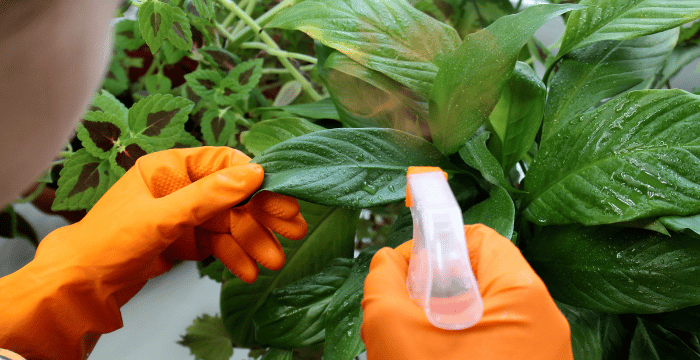
Indoor plants not only add a touch of nature to your living space but also purify the air and improve your overall well-being. However, to keep them looking their best and functioning efficiently, it’s crucial to clean their leaves regularly. Dust and grime can accumulate on the leaves, blocking sunlight and hindering photosynthesis. This guide will walk you through various methods to clean indoor plant leaves effectively.
Why Cleaning Indoor Plant Leaves is Important
Before diving into the cleaning methods, let’s understand why it’s important to clean indoor plant leaves:
- Improved Photosynthesis: Dust and dirt on leaves can block sunlight, reducing the plant’s ability to photosynthesize efficiently.
- Healthier Plants: Clean leaves can better absorb nutrients and moisture, leading to healthier growth.
- Aesthetic Appeal: Dust-free leaves make your indoor plants look more vibrant and attractive.
- Pest Prevention: Regular cleaning helps detect and prevent pest infestations early.
For more details on dealing with issues like mold on your indoor plants, check out our guide on why my plant has mold?
Best Methods to Clean Indoor Plant Leaves
1. Dusting with a Soft Cloth
For light dust, use a soft cloth or microfiber cloth to gently wipe the leaves. Here’s how:
- Materials Needed: Soft cloth or microfiber cloth.
- Steps:
- Support the leaf with one hand to avoid damage.
- Gently wipe the leaf from the base to the tip.
- Repeat on both sides of the leaf if necessary.
2. Showering Your Plants
A gentle shower can remove a significant amount of dust and grime from your plant leaves.
- Materials Needed: Shower or sink with a spray nozzle.
- Steps:
- Place the plant in the shower or sink.
- Use lukewarm water to keep the plant comfortable and avoid any shock.
- Gently spray the leaves, ensuring all dust is washed off.
- Allow the plant to drip dry before returning it to its spot.
3. Using a Soft Brush
For plants with hairy or fuzzy leaves, a soft brush can be more effective than a cloth.
- Materials Needed: Soft brush (e.g., paintbrush or makeup brush).
- Steps:
- Gently brush the leaves to remove dust.
- Be careful not to damage the delicate leaf surface.
4. Cleaning with a Soap Solution
For plants with sticky residues or stubborn dirt, a mild soap solution can help.
- Materials Needed: Mild liquid soap, water, soft cloth, or sponge.
- Steps:
- Mix a few drops of gentle liquid soap into some water.
- Dip the cloth or sponge in the solution.
- Gently wipe the leaves, supporting them with your hand.
- Rinse the leaves with clean water to remove soap residue.
- Allow the plant to air dry.
5. Using Leaf Shine Products
Leaf shine products can add a glossy finish to your plant leaves, making them look more vibrant. However, use them sparingly and only on suitable plants.
- Materials Needed: Commercial leaf shine product.
- Steps:
- Follow the instructions on the product label.
- Spray or wipe the product onto the leaves.
- Avoid overuse to prevent clogging the leaf pores.
Tips for Cleaning Different Types of Indoor Plants
Different plants require different cleaning methods based on their leaf structure and sensitivity. Here are some tips for various types of indoor plants:
Foliage Plants (e.g., Philodendrons, Pothos)
- Use a soft cloth or shower method.
- Avoid using harsh chemicals or abrasive materials.
Succulents and Cacti
- Use a soft brush to remove dust.
- Try to keep water off the leaves to prevent rot.
Fuzzy-Leaved Plants (e.g., African Violets)
- Use a soft brush or blow off dust gently.
- Avoid getting the leaves wet to prevent mold and mildew.
Large-Leaved Plants (e.g., Monstera, Rubber Plant)
- Use a soft cloth or sponge with a gentle soapy water mixture.
- Wipe both sides of the leaves thoroughly.
Preventive Measures to Keep Plant Leaves Clean
- Regular Maintenance: Dust your plants regularly to prevent the buildup of dirt.
- Proper Placement: Keep plants away from dusty areas or high-traffic zones.
- Humidifiers: Using a humidifier can help reduce dust accumulation on plant leaves.
- Inspect Plants: Regularly check for pests and treat them promptly to prevent infestations.
Common Mistakes to Avoid
- Using Harsh Chemicals: Avoid using strong detergents or chemicals that can damage the leaves.
- Overwatering: Ensure the soil doesn’t stay waterlogged after cleaning.
- Ignoring Plant Sensitivity: Be mindful of each plant’s specific needs and sensitivities.
FAQs
How often should I clean my indoor plant leaves?
It depends on your environment, but generally, once a month is a good practice.
Can I use household cleaners to clean plant leaves?
It’s best to use mild soap and water, as household cleaners can be too harsh.
Why are the tips of my plant leaves turning brown?
Brown tips can be caused by several factors, including overwatering, underwatering, low humidity, or too much fertilizer. Check your plant care routine and adjust accordingly.
